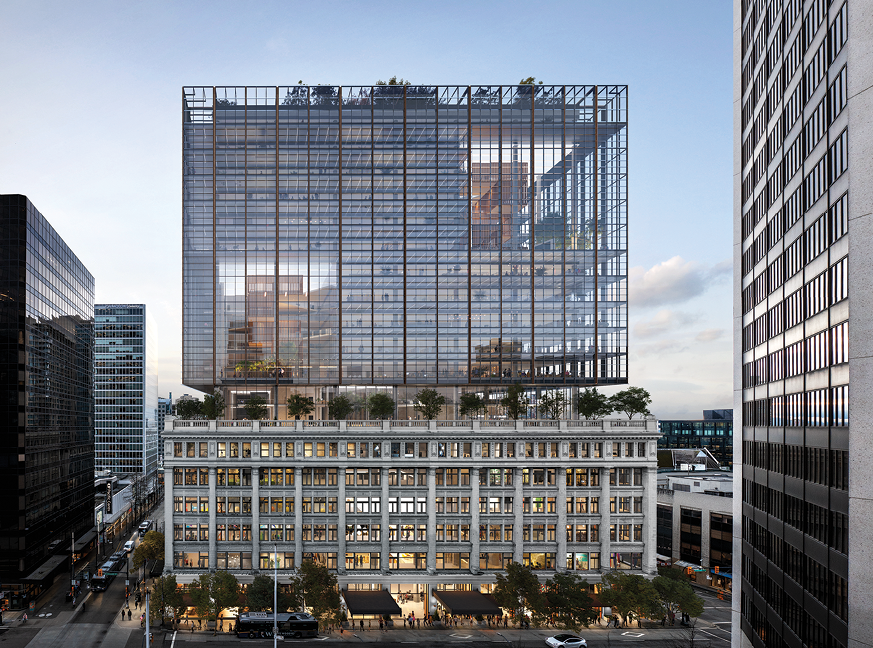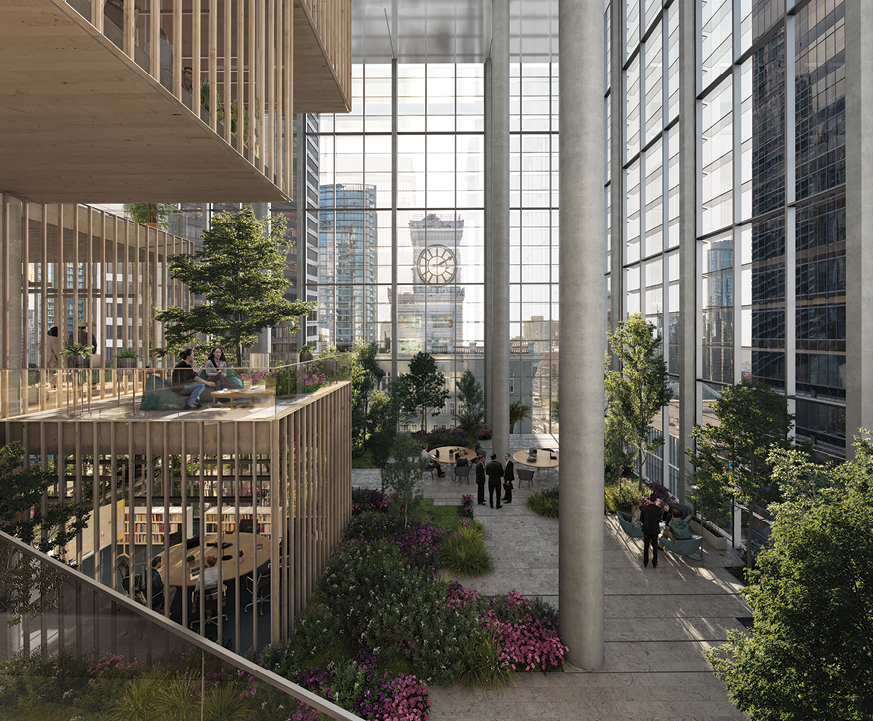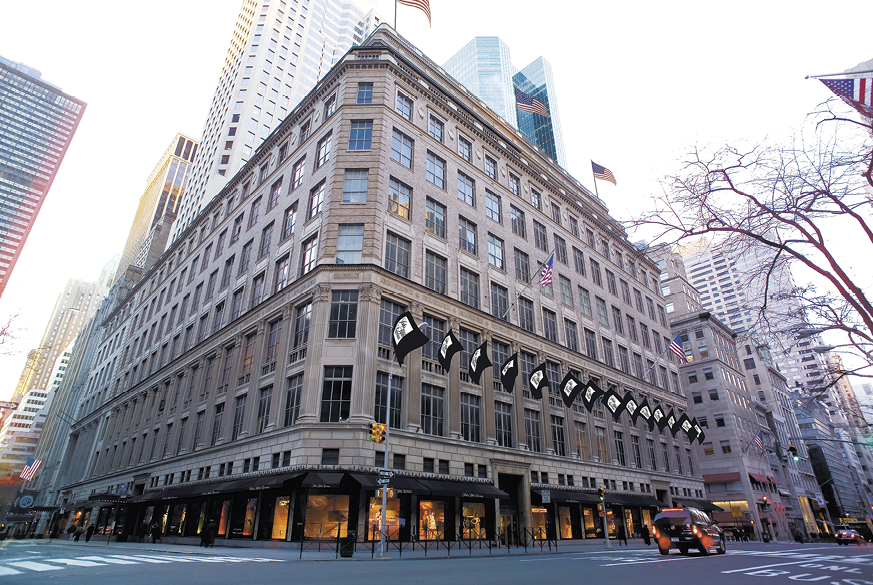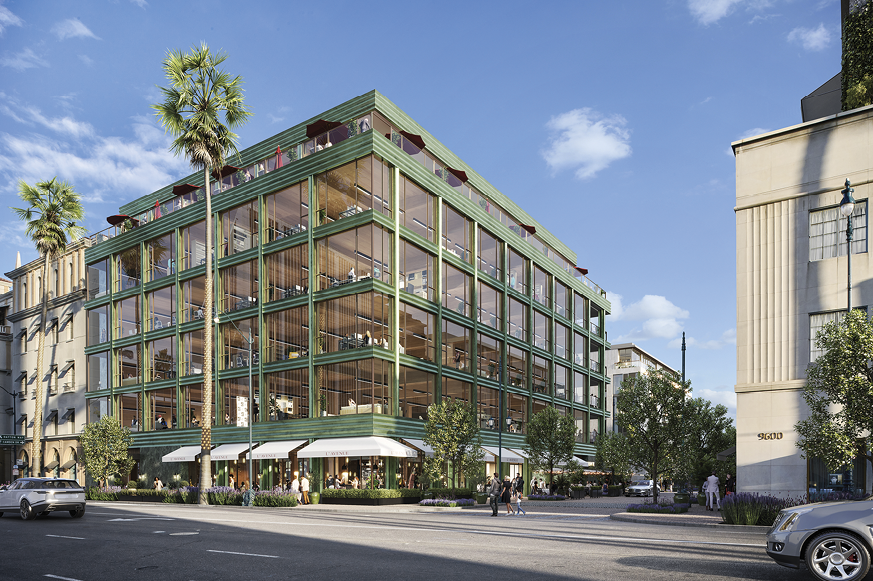- Home
- Media Kit
- MediaJet
- Current Issue
- Past Issues
- Ad Specs-Submission
- Ad Print Settings
- Reprints (PDF)
- Photo Specifications (PDF)
- Contact Us
![]()
ONLINE
![]()
ONLINE

A Company of Adventurers
Editors’ Note
Richard Baker is a chief executive and entrepreneur who serves as the Governor, Executive Chairman, and CEO of Hudson’s Bay Company, the historic Canadian retailer that he took private in March 2020. Since purchasing HBC in 2008, Baker has expanded North America’s oldest company into a holding company of eight portfolio companies: Saks Fifth Avenue, Saks OFF 5TH, Saks.com, Convene, Hudson’s Bay, The Bay, HBC Properties and Investments, and O5. Under Baker’s leadership, HBC has expanded from retail into real estate and technology. Baker is an active philanthropist and supporter of his alma mater, Cornell University.”
Company Brief
Hudson’s Bay Company (hbc.com) is a holding company that invests in technology, retail, and real estate businesses, and works to maximize value at the crossroads between these spaces. It is the majority owner of iconic ecommerce companies: Saks, a leading online destination for luxury fashion; The Bay, a Canadian ecommerce marketplace; and Saks OFF 5TH, a premier luxury off-price ecommerce company offering top brands at the best prices. These businesses were established as separate operating companies in 2021. HBC also wholly owns Hudson’s Bay, the operating company for Hudson’s Bay’s brick-and-mortar stores, as well as SFA, the entity that operates Saks Fifth Avenue’s physical locations, and O5, the operating company for Saks OFF 5TH stores. With assets spanning top markets and prime locations across North America, HBC owns or controls – either entirely or with joint venture partners – approximately 40 million square feet of gross leasable area. HBC Properties and Investments, the company’s real estate and investments portfolio business, manages these assets along with additional real estate offerings, including Streetworks Development, its property development division. Founded in 1670, HBC is North America’s longest continually operating company and is headquartered in New York and Toronto.

HBC’s flagship building in Vancouver
Will you discuss the history and heritage of Hudson’s Bay Company and how the business has evolved?
What is interesting, and what most people don’t know, is that the company dates all the way back to the 1600s. Lord Rupert, the cousin of King Charles II of England, displayed an early interest in exploring the lucrative fur trade found in an area made accessible by the Hudson Bay. In 1670, the Royal Charter granted exclusive trading rights of the Hudson Bay watershed to the Governor and the accompanying adventurers. In fact, that document from 1670 still sits in my office today at our Toronto headquarters. Rupert put together a company to send people over from Europe to Hudson Bay; these adventurous souls would get on a boat and go to York Factory, which was located on the southwestern shore of Hudson Bay. They would trade beaver pelts, blankets, and supplies with the indigenous people, among many other things. While they may not trade those items any longer, it is that adventurous spirit that has contributed to Hudson’s Bay Company’s longevity. The company has continuously operated for 352 years, making it North America’s longest continually running company, and I am honored to continue its legacy as the 39th Governor of the Hudson’s Bay Company.
Many of us talk about how companies are about culture and leadership; I can say that same adventurous spirit within Hudson’s Bay Company remains strong today. The activities of HBC over the past 15 years have very much replicated our initial DNA and culture. No matter how Hudson’s Bay Company progresses, it is that adventurous spirit that will always drive Hudson’s Bay Company’s evolution.
Is there one HBC culture or do each of the businesses have their own distinct culture?
That is a great question. First, we have to zoom out a bit. We have acquired, assembled and invented a whole series of companies that reside under the HBC umbrella. Each one of these companies has its own, unique identity. For example, what goes on in Saks Fifth Avenue is very different from what goes on in Canada at Hudson’s Bay, just like what goes on at Convene is very different from what goes on at Saks OFF 5th. They are different companies catering to the needs and wants of different consumers. The one-size-fits-all playbook would not make a great deal of sense here.
That said, there is a common culture that exists across all of our companies. When we purchased Hudson’s Bay Company, it was a series of five different companies all being operated with one team. At that point, it was an underperforming enterprise that was not living up to the potential I knew it possessed. The first task we accomplished was splitting the business up into five separate companies with different management teams. We also, at the same time, reinvigorated and revamped our famed history and culture. On the sheer strength of our culture, we were able to reinvent and reimagine each of these five companies. Some were sold off and others were kept, some of which we continue to operate today.
At Hudson’s Bay Company, and its subsidiaries, we prize entrepreneurship and pioneering adventurers. It is about taking very thoughtful and calculated risks at a very fast pace. This allows us, in the fast-moving world we live in, to adjust very rapidly. Whether it is a pandemic, a recession, or a digital revolution, this company of adventurers has been able to pivot and create value during challenging times.
Our hiring process places a great deal of emphasis on values. We make sure that all new hires, first and foremost, match our values and the shared culture we have built: thoughtfulness and tact, intrepidness and introspection. We only hire inspired, quick-thinking, and value-driven team members. These are the individuals that contribute to an enduring culture. It’s one that a storied company like Hudson’s Bay needs.

HBC’s flagship building in Vancouver
How has HBC been able to stay nimble and entrepreneurial as it has grown in size and scale, and what have been the keys for HBC’s ability to continue to create new companies?
We spend a lot of time sourcing and nurturing entrepreneurial talent within our companies. As the leader of HBC, I spend a large percentage of my time instilling our culture and the values that we celebrate across the company. One key to staying nimble and entrepreneurial is intentionally fostering this attitude in the workplace. When I say I spend a large amount of time instilling this culture, that is what I mean. I encourage ideating and idealism. Without outside-the-box thinking, growth and innovation become casualties.
Additionally, and perhaps contrary to the experience of many, we celebrate people who can think differently than other people, and we celebrate people who take risks and try new things – with limited downside. It’s the combination of our management team sharing these values and our commitment to hiring and training eclectic entrepreneurs who have a creative twist that enables us to evolve. As a result of this balance, we can weather great change rather than stagnating, which we have seen time and time again across our sectors and the business community at-large.
Many big corporations, by the nature of their size, tend to squeeze out the creatives and entrepreneurs because they are constantly trying to control risk. When those people are taken out of the organization, the companies are left without creativity. These companies become lifeless and staid. Risk-taking – controlled risk-taking – is what breeds innovation and growth.
This entrepreneurial spirit, as you can imagine, is what gives us the lens through which we see new opportunities for expansion where others may not. Creating new companies requires an unwavering commitment to controlled risk-taking. At the hands of this culture, our company is chock full of individuals who take concepts and ideas that have long been employed and give them new life. That is how we keep innovating and expanding Hudson’s Bay Company.

Saks Fifth Avenue’s flagship store in New York City
How do you describe the value of HBC’s brands and platform?
One of the lessons I have learned over the years is that the value of brands or the value of platforms is perhaps the most valuable asset under management. When people visit Saks Fifth Avenue in Manhattan, they are, in part, going for the experience. The aura of that Saks Fifth Avenue is undeniable. That is what I mean when I talk about the power and value of a brand and a platform. When I say, “Saks Fifth Avenue,” an immediate image comes to mind. For those in Canada, the same is true of Hudson’s Bay Company. That value is what we can’t afford to lose. When people come to expect something – something excellent – you have to continue nurturing that image and fostering it.
That being said, change is one of the few inevitabilities in business and in life. That means that while the brand and value of a Hudson’s Bay or a Saks Fifth Avenue must be nurtured, it must also remain nimble and subject to change. That is why I am particularly proud of the work we have done with Saks. We bought Saks at a time when many questioned the logic of a luxury retailer. Not only has the Saks franchise and all of its businesses gone from $2.5 billion in sales (from when we bought it in 2013) to $6.5 billion in sales this year, but, most importantly, we were able to retain and polish the Saks brand. We increased sales exponentially, retained the value of the Saks brand, and took Saks in some new, digital directions that have proved the value of a culture that emphasizes imagination and creativity.
What are your views on the impact of technology on retail and how is HBC addressing the digital revolution?
For brick-and-mortar companies like ourselves, digital transformation presents both opportunities and challenges. Not only do we need to compete with other traditional retailers and meet the profitable EBITDA that investors and owners expect; as the industry embraces technology, we also must compete with digital-only retailers operating against completely different evaluations.
We are constantly looking for ways to leverage technology, not only to transform the traditional retail environment, but to also adapt to the digital revolution. In 2021, we made the deliberate decision to split our digital businesses from their brick-and-mortar counterparts, which were already separated from our real estate business. As a result, each of our four core brands has its own digital, operating, and real estate arms. With this approach, we are not only able to attract real estate, digital, and operating company investors and increase our competitive advantage, but also bring established brands into a new era of agility and innovation.
Where do you see the greatest growth opportunities for HBC as you look to the future?
Broadly speaking, I’m optimistic about future growth opportunities. We have seen outsized growth based on the competition set within each category. The value of our real estate has done better than similar real estate. Our brick-and-mortar operating businesses have gotten a lot of wind from digital marketing and are performing quite well compared to their competitors in the brick-and mortar space.
We have also been outperforming our competitors in the digital space, due in part to the added benefits provided by offering both digital and brick-and-mortar customer experiences.

HBC’s expansion of Saks Fifth Avenue Beverly Hills
What are your views on the future relevance of brick-and-mortar?
That is a question I get asked a lot. As it currently stands, brick-and-mortar still accounts for more than 80 percent of all retail sales. I think this fact is often lost on people because of the proliferation of e-retail, which is something to be taken seriously.
That being said, there are successful and unsuccessful companies in every category, and at HBC, our focus every day is to serve our customers, develop dedicated team members, maintain an entrepreneurial spirit, and run great businesses.
Some people see brick-and-mortar as rather old hat, but I think that flies in the face of the existing evidence. If you look at Saks Fifth Avenue, our sales have increased tremendously since we bought it in 2013, while a number of our competitors have gone bankrupt or disappeared. While Saks.com and the digital side of Saks has also been an amazing success for us, there is a tremendous staying power that Saks Fifth Avenue has. You can’t enjoy that magical experience from behind a screen. And therein lies the power of brick-and-mortar.
So, I see the future being the best brick-and-mortars working in tandem with their digital partners to provide consumers with the ultimate experience. We have made a lot of positive progress on both of those fronts and we see a lot of opportunity ahead of us.
How do you define the meaning of the word luxury?
The word luxury, to me, means a high-quality brand with limited distribution that also has a high focus on providing a level of quality to their customer. When people think of luxury, they often think of glitz and glamor. While that may be the case, it is much deeper than that, of course.
Luxury comes with a proposition from the seller that you, the consumer, will be treated in a manner befitting the one and only customer of the world. Luxury means we will cater to your every need. Luxury means a relationship, a real relationship, will be forged between buyer and seller, customer, and employee.
We are in the pure luxury business and, if we stay true to that definition of luxury, it is not leaving here anytime soon.
How important is it for HBC to build a diverse and inclusive workforce?
Very important. It is something we at Hudson’s Bay recognize and prize, and something we know is crucial to our continued scaling and innovation. We know the customers we serve are not a monolith, and our customers want to see those differences reflected in our company and in our stores. A diverse company produces diverse thinking – something we love and have baked into our culture.
At the same time, maintaining a diverse team also allows us to better understand cultural sensitivities and be aware of how others may perceive words and actions. This is something particularly poignant at a company like HBC, where the history of the company is something we are still working to make amends for today.
That is why we are always striving to bring new and diverse perspectives, backgrounds, and groups into the fold.
What do you see as HBC’s responsibility to the communities it serves and to be a force for good in society?
We consider the communities we operate in – whether that be a physical store location, our network of customers and associates, or our online community – as partners in our growth. To that end, we have thought long and hard about how we can best participate in our communities.
Foremost is the Hudson’s Bay Company’s responsibility to Canada’s Indigenous communities. It is no secret that this company has a storied, winding past, and – like any organization that’s existed for more than 350 years – its history is at odds with a 21st-century mindset and contemporary values. Historically, the Hudson’s Bay Company made mistakes in their interactions with Indigenous peoples. That doesn’t mean we should shy away from that relationship. On the contrary, it means we have an obligation to make amends for past transgressions and right those wrongs. As part of our company’s efforts to make positive headway in the relationship between the Bay and the Indigenous community of Canada, I was honored to donate our historic department store in downtown Winnipeg to the Southern Chiefs’ Organization (SCO) earlier this year and work closely with SCO Grand Chief Jerry Daniels on that act of reconciliation. We all have a responsibility to work together in order to make for a more peaceful community – for all. That is why we look forward to maintaining close ties with the SCO as they develop affordable housing, a childcare center, and other meaningful uses at the site to help support Winnipeg’s downtown transformation.
Additionally, with each property development, we strive to work closely with residents, local officials, and neighboring businesses to help support and strengthen the surrounding area. Whether we are repurposing a store location or starting from scratch, we have a responsibility to understand the unique wants and needs of each community, and respect them in our business. We’re especially proud of the close work we’ve done with the communities in Beverly Hills and in Westfield, New Jersey, this year. We look forward to being a partner in reimagining their respective downtowns.
For years, my wife, Lisa, and I have also been devoted to mental health advocacy and awareness. For us, it’s about creating communities for those who have none. Over time, I saw the great opportunity we have to bring our personal devotion to HBC and leverage our business to support community-building and effect positive change.
When we started, conversation about mental health in the workplace was sparse. But we could see the value – and the need – in creating a sense of belonging within and outside the workplace. Being a force for good in the community does not stop at responsible business practice – it means addressing the challenges facing those around us, and doing what we can to alleviate them. Every associate, customer, and resident connected to our businesses – and to our personal lives – can be affected by mental health issues, and so we have spent a great deal of time raising money and contributing in any way we can to reducing the stigma of mental health and supporting those who are dealing with this issue.
How challenging is it to balance your time in running the business with your focus on philanthropic work?
Finding balance can sometimes be challenging. I am laser-focused on – and often totally consumed by – building our business and working with our team members to serve customers. In fact, I sometimes find myself needing to step back in other areas because I realized I don’t have the capacity at that moment to be impactful.
Having said that, I do spend time on more personal causes as well. Philanthropy has been and remains a priority for me, and as I mentioned, my wife and I are passionate about mental health advocacy. So, I do spend a great deal of time and energy on turning that devotion into action to make the world a better place.
What are your views on the future of work?
Right now, we have an opportunity to evolve. With a current and upcoming workforce that has adapted to a hybrid world – and the benefits and challenges we’ve seen as a result – I believe the future of work will take place in a spectrum of environments. Some will remain fully remote, some will return to the office, and some will do both.
For these reasons and more, we have spent a tremendous amount of time thinking about the future of work. First and foremost, we recognize that taking a “one-size-fits-all” approach to the office doesn’t work for our needs. We have roughly 25,000 team members, so it’s important that we have the right environment for different types of people and places.
Additionally, HBC Properties and Investments – our real estate arm – has fully embraced this evolving landscape. With our earlier recapitalization of SaksWorks with Convene – a premium flex operator of meeting spaces – we’re executing our vision for a future of work centered around choice, flexibility, and connection.
In the end, there are pros and cons to either reality. I do believe that there are many efficiencies in not having to commute, but I also believe that there are many benefits to culture and collaboration when working together in an office environment. But one thing is certain – the workforce of the future is going to be very different, and each company and each leader will need to find a way to thread the needle to maximize opportunities and accomplish their goals.
How do you focus your efforts leading HBC and how do you describe your management style?
It’s important to me that I empower the leaders I work with to take point. Each of our businesses is led by a very capable operating CEO with unique insights into each business. I meet each week with a dozen or so different leaders to stay up to date on their world and provide guidance – and when needed, I’ll support and back them in their entrepreneurial pursuits. But otherwise, I trust them to get the job done.
With this approach, I can act as an available resource for each business leader without keeping them under a microscope. No operating CEO wants to have me sitting next to them all day long, but having a sounding board that they can brainstorm with and bounce ideas off of has been valuable. I see myself as the resident entrepreneur.
Did you always know that you had an entrepreneurial spirit and desire to build your own company?
I was always entrepreneurial. Sitting at a desk and rote memorization were not really avenues in which I excelled – I was much better at getting other people to help me do what I needed to do to execute creative, outside-the-box ideas.
I had a catering business in high school and entrepreneurial businesses in college. I was enthralled at an early age at the concept of owning the real estate of your own operating business, and at the time, while I did not know the words PropCo, OpCo, and DigCo, looking back at my 12-year-old self, that is exactly the guy I wanted to be. Today, I am a PropCo, OpCo, and DigCo guy, and it has turned out quite well.
While I am a businessperson, I tend to see my thought processes as resembling those of an artist more than anything. In my brain at any given time are 36 channels clicking away from one channel to the next. Those 36 different channels, however, are, to me, 36 different canvases that I’m painting. On each canvas, I work with these great teams of people: one might be the renovation of a building; another one might be focusing on a certain aspect of growing a particular business; another one might be the future business plan of a project that we’re working on. To me, as I think about it, they’re all canvases, and I’m working in my head through each one of those channels – through each one of those canvases.
What advice do you offer to young people beginning their careers?
I tell them to find something they are passionate about, find a mentor, and go to the office.
Are you able to enjoy the process and celebrate the wins, or are you always looking at what is next?
We certainly have big aspirations and plans for the future, and I’m excited to see where we go next. But I also believe that, as you get older, you begin to appreciate the journey. When I think about what we have accomplished over the years, I’m humbled. And inspired. What started with a $25 million check in 2006 has grown into an enterprise over $6 billion – more than we ever could have imagined. In a way, acknowledging how far we’ve come brings even more anticipation for the future.![]()